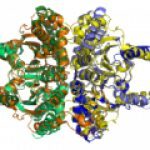Lien vers Pubmed [PMID] – 19769988
J. Mol. Biol. 2009 Dec;394(3):522-34
The biologically active state of many proteins requires their prior homo-oligomerisation. Such complexes are typically symmetrical, a feature that has been proposed to increase their stability and facilitate the evolution of allosteric regulation. We wished to examine the possibility that similar structures and properties could arise from genetic amplifications leading to internal symmetrical repeats. For this, we identified internal structural repeats in a nonredundant Protein Data Bank subset. While testing if repeats in proteins tend to be symmetrical, we found that about half of the large internal repeats are symmetrical, most frequently around a rotation axis of 180 degrees . These repeats were most likely created by genetic amplification processes because they show significant sequence similarity. Symmetrical repeats tend to have a fixed number of copies corresponding to their rotational symmetry order, that is, two for 180 degrees rotation axis, whereas asymmetrical repeats are in longer proteins and show copy number variability. When possible, we confirmed that proteins with symmetrical repeats folding as an n-mer have homologues lacking the repeat with a higher oligomerisation number corresponding to the rotation symmetry order of the repeat. Phylogenetic analyses of these protein families suggest that typically, but not always, symmetrical repeats arise in one single event from proteins that are homo-oligomers. These results suggest that oligomerisation and amplification of internal sequences can interplay in evolutionary terms because they result in functional analogues when the latter exhibit rotational symmetry.


